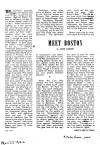
Home Page Meet Boston Menu Index
|
MEET BOSTON Friday, March 27, 1942 in What's New In Town W. J. Sidis |
We commonly associate mirages with deserts and suchlike out-of-the-way places. And yet Boston has seen as authentic mirages as any desert, though maybe not so often. When you are on a highway on a hit summer day, and the road ahead in the distance seems to be under water, but that “water” vanishes when you come closer―you have seen just such a mirage as gives the appearance of vanishing lakes in the desert. In both cases, the “water” is really a pocket of hot air. In Greene’s* “American Descriptions,” an unpublished book giving some interesting descriptions of incidents in America, the following is vouched for as having been seen from a Cambridge office building in June, 1938: “A marine scene was seen in the sky, hanging over Boston. There were plenty of boats visible and behind was a long, sandy beach, with a village to be seen. This lasted about two hours, when the scene disappeared slowly, from left to right. During that time, some of the boats had moved, but the scene (believed to be some part of Cape Cod) was otherwise unchanged. In May, 1939, a similar mirage was seen from a Boston waterfront building, by at least three persons present there. Another ocean appeared to be hanging over Winthrop, with some rocky islands identified by one of the witnesses as the Isle of Shoals in New Hampshire. Boats were bustling around in the foreground, going back and forth, and gathering about one spot. A later checkup indicated that the rescue of the crew of the submarine “Squalus” took place at that time near the Isle of Shoals and about 50 miles from Boston.”
*
Dorchester, unlike other parts of Boston, was settled by the Pilgrims, before any Puritans had reached the head of Massachusetts Bay. The “Dorchester Pilgrims” were heading for Boston Harbor, but missed their destination and reached the wrong inlet, a bay surrounded by flat beaches; and on the hills near that shore they settled Dorchester. The settlement of Charlestown and Boston followed a few months later, while the Dorchesterites, regarding Boston Harbor as a new upstart, called the bay where they landed the Old Harbor. It still goes by that name, though it is really unsuitable for harbor purposes, but has several excellent beaches.
*
When the Civil War started, the first Northern troops to head south came from Boston. On [Thursday] April 18, 1861, the Sixth Massachusetts Regiment entrained at the old Fall River Line depot, took the Fall River Line boat from Fall River to New York, then the ferry to Jersey City and the Baltimore & Ohio train to Baltimore. While crossing Baltimore, they ran into the first battle of the Civil War, when they were attacked by the people of that city. Nevertheless, the metropolitan regiment got through to Washington, and, for several weeks, the Bostonians held Washington alone against Confederates who had them surrounded. The glee club of the regiment, while on this trip, started the song, “John Brown’s Body.” The old depot from which they started has become the express building of South Station. And another well-known song, “Maryland, My Maryland,” expresses the Southern reaction to the Baltimore fracas.
*
Boston once had an elaborate depot building that was not used as such for more than a couple of years. It is, however, still an impressive-looking edifice, and much larger than any railroad station on the Pacific Coast or in many other parts of this country, even today. This building was finished by the Boston and Albany Railroad in 1881, for use as its own Boston terminal. It appears, however, to have had the effect of blocking traffic on Kneeland Street―then a more important artery than now. Anyway, by 1884 this impressive depot―larger than any railroad station outside of Boston―was abandoned as a railroad terminal, and turned over to railroad and express offices, while a “false front” was constructed for the train shed, with a small waiting room, the other side of Kneeland Street. In spite of the more recent brick-wall portions in the building, the skylights of what is still called the Albany building, give an idea of the former splendor of the immense waiting room, now reduced to a small lobby. This was one of the first public buildings to be lit by electric lights.
___________
* This is Sidis's "Parker Greene" pseudonym. The office building is likely 905 Central Square Bldg., Cambridge. See his Continuity News.